Attigny, Ardennes
Attigny (French pronunciation: [atiɲi] ⓘ) is a commune in the Ardennes department in the Grand Est region of north-eastern France.
Attigny | |
|---|---|
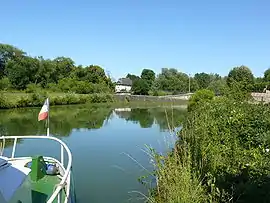 The Canal des Ardennes at Attigny | |
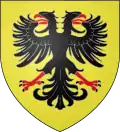 Coat of arms | |
Location of Attigny | |
 Attigny 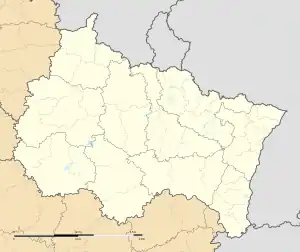 Attigny | |
| Coordinates: 49°28′42″N 4°34′42″E | |
| Country | France |
| Region | Grand Est |
| Department | Ardennes |
| Arrondissement | Vouziers |
| Canton | Attigny |
| Intercommunality | CC Crêtes Préardennaises |
| Government | |
| • Mayor (2020–2026) | Chantal Henriet[1] |
| Area 1 | 11.46 km2 (4.42 sq mi) |
| Population | 1,112 |
| • Density | 97/km2 (250/sq mi) |
| Time zone | UTC+01:00 (CET) |
| • Summer (DST) | UTC+02:00 (CEST) |
| INSEE/Postal code | 08025 /08130 |
| Elevation | 77–133 m (253–436 ft) (avg. 83 m or 272 ft) |
| 1 French Land Register data, which excludes lakes, ponds, glaciers > 1 km2 (0.386 sq mi or 247 acres) and river estuaries. | |
The inhabitants of the commune are known as Attignatiens.[3]
The commune has been awarded one flower by the National Council of Towns and Villages in Bloom in the Competition of cities and villages in Bloom.[4]
Geography
Attigny is located some 16 km east by south-east of Rethel and 14 km west by south-west of Le Chesne. Access to the commune is by the D 987 road from Charbogne in the north passing through the village and continuing south to Coulommes-et-Marqueny. The D 983 road comes from Givry in the west passing through the village and continuing south-east to Vrizy. The D 25 road comes from Saulces-Champenoises in the south-west merging with the D 983 west of the village then continuing north-east to Rilly-sur-Aisne. There is also a railway with a station just north of the village. There is the hamlet of La Couture east of the village. The town has a large residential area with the rest of the commune farmland.[5]
The river Aisne runs through the commune as it flows west to eventually join the Seine at Conflans-Sainte-Honorine. The Canal des Ardennes is close to and parallel to the Aisne. The Ruisseau de Saint-Lambert flows into the Aisne from the north.[5]
Neighbouring communes and villages
History
Middle Ages
In the Middle Ages Attigny had some importance as it had had a royal residence since Clovis II who built a palace there in 647. It was also the Carolingian imperial residence, and Charlemagne is said to have attended many Christmas and Easter festivals there. Charles the Bald stayed many times at the palace.
The first Council of Attigny was convened at Attigny in 765 by Pepin the Short. It was a general assembly of the Frankish nation that was continued as a synodal council.
The council made a decree: "pro causa religionis et salute animarum" which was signed by twenty-seven bishops (including the bishops: Remigius of Rouen, Jacob de Toul (24th Bishop of Toul), Chrodegang of Metz, Magdalvé of Verdun, Fulcaire or Tungrensis of Liège, Maurinus of Évreux, Willicaire of Vienne) and seventeen abbots (such as Abbot Godobert of Rebais). It involved a form of alliance in the event of death. Each of the bishops and abbots who signed this document committed, on the death of a member of the alliance, to sing 100 psalms and the priests to celebrate 100 Masses. Each of the bishops himself was to celebrate thirty masses and if he was prevented by illness or some other cause, he should appoint another bishop care to celebrate for him. Similarly, the abbots who were not bishops should appoint a bishop to say these thirty masses. Finally the monks who were priests were to celebrate 100 Masses and the monks who were not should sing 100 psalms.[7]
In 785, Charlemagne held a council at Attigny where Saxon Duke Widukind, main enemy of Charlemagne during his wars against the Saxons (772-805), and Aboin received baptism from Charlemagne.
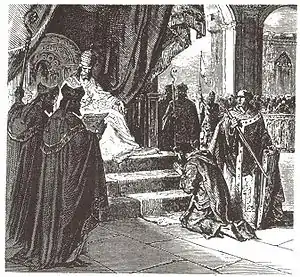
In 822, Pope Paschal I was present at a Council of Attigny, convened for the reconciliation of the emperor Louis the Pious with his three younger brothers, Hugo, Drogo and Theodoric, whom he had caused to be violently tortured and whom he had intended to put to death. In the council he confessed publicly his wrongdoing; also the violence practiced by him on his nephew, Bernard, King of Italy, and his brother, the Abbot, Adelard Wala, and proposed to perform public penance in imitation of the emperor Theodosius I. He also exhibited an earnest desire to correct abuses arising from the negligence of the bishops and the nobles and confirmed the rule (Aquensis Regula) that the Council of Aachen had drawn up in 816 for canons and monks.
In 870, thirty bishops and six archbishops met at Attigny, to pass judgement on Karlomann, the king's son, made an ecclesiastic at an early age, and accused by his father of conspiring against his life and throne. He was deprived of his abbeys and imprisoned at Senlis.
In the council of 875 Hincmar, Bishop of Laon appealed to the pope for his uncle, Hincmar, Archbishop of Reims.
In 880 the Battle of Attigny was fought between a Carolingian coalition against an army of Boso - self-proclaimed King of Provence.
In 916 Charles the Simple transported relics of Saint Walpurga to Attigny and founded a chapel served by twelve canons[8] and his intention was that this chapel would be subject to the Abbey of Saint-Corneille at Compiègne.[9]
The Carolingians abandoned the residence before 931 and the palace disappeared after the 10th century. Attigny was also a royal domain and remained so when it ceased to be a royal residence of the Carolingians. At the beginning of the 10th century it encompassed at least 3,500 hectares. Donations of land to the Church remained limited. The domain passed almost intact to the smaller Capetian royal domain. It formed the dowry of the daughter of Philip I, Constance, on her marriage to Hugh, Count of Champagne, in 1093. The domain was split apart by the prince, especially for the benefit of Reims Cathedral, and is the origin of the ecclesiastical lordships of Attigny and Sainte-Vaubourg.[10]
A leper colony was documented in the 14th century.
Contemporary era
_croix_de_chemin_%C3%A0_cot%C3%A9_du_pont.JPG.webp)
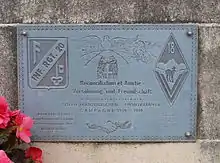
The town was badly damaged by the two world wars.
From 14 May to 10 June 1940 the 18th Infantry Regiment of Pau fought at Attigny. For 25 consecutive days it repelled successive attacks by an enemy superior in numbers and resources. They left their position in order, their flanks being threatened by the German advance.
The town was destroyed in 1914 and 1940. Attigny holds two Croix de Guerre, one from each world war. A monument to the 18th Infantry Regiment was inaugurated on 20 September 1947 near the canal bridge. A plaque celebrating Franco-German reconciliation was later affixed by the Fellowship of the French 18th regiment and the German 20th Infantry Regiment of Ratisbonne. This regiment was part of the attacking German forces at Attigny.
Heraldry
 Arms of Attigny |
Blazon: Or, a double-headed eagle of Sable, beaked, langued, and membered in Gules.
|
Decorations

Croix de guerre 1914-1918 : 4 September 1920[11]
Croix de guerre 1939-1945 : 12 February 1949[12]
Administration
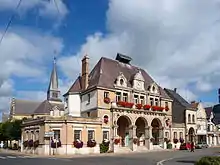
List of Successive Mayors[13]
| From | To | Name |
|---|---|---|
| 1995 | 2006 | Michel Bazelaire |
| 2006 | 2020 | Noël Bourgeois |
| 2020 | current | Chantal Henriet |
Demography
In 2017 the commune had 1,128 inhabitants.
|
| ||||||||||||||||||||||||||||||||||||||||||||||||||||||||||||||||||||||||||||||||||||||||||||||||||||||||||||
| Source: EHESS[14] and INSEE[15] | |||||||||||||||||||||||||||||||||||||||||||||||||||||||||||||||||||||||||||||||||||||||||||||||||||||||||||||
Culture and heritage
Civil heritage


The commune has a number of buildings and structures that are registered as historical monuments:
- A sugar refinery (1864)
 [16]
[16] - A Milk and Cheese factory (20th century)
 [17]
[17] - A Brickworks (1919)
 [18]
[18] - The Palace of Charlemagne (16th century)
 [19]
[19]
The Town Hall contains a Painting with frame: Marriage in Assyria (19th century)![]() which is registered as a historical object.[20]
which is registered as a historical object.[20]
Religious heritage
The Church of Notre-Dame (11th century)![]() is registered as a historical monument.[21]
is registered as a historical monument.[21]
The Church contains several items that are registered as historical objects:
- Bas-relief: Descent from the Cross (16th century)
 [22]
[22] - 4 Statues: Saints Nicolas, Éloi, Marthe, and Laurent (16th century)
 [23]
[23] - Tombstone (17th century)
 [24]
[24] - Stained glass windows (15th century)[25]
- Main Altar (17th century)[26]
- The Church
 Church of Notre-Dame
Church of Notre-Dame_%C3%A9glise_Notre-Dame%252C_vue_du_sud.JPG.webp) Church of Notre Dame from the south
Church of Notre Dame from the south The Altar
The Altar The Nave
The Nave Stained glass windows
Stained glass windows Statue
Statue
- Other sights in the commune
 House of André Dhôtel
House of André Dhôtel%252C_ici_est_n%C3%A9_Andr%C3%A9_Dh%C3%B4tel_01.JPG.webp) House of André Dhôtel
House of André Dhôtel The Canal des Ardennes
The Canal des Ardennes Port on the Canal
Port on the Canal Autorail X3943 preserved at the station
Autorail X3943 preserved at the station_monument_aux_morts.JPG.webp) War memorial
War memorial 18th Regiment memorial
18th Regiment memorial War cemetery
War cemetery_kiosque_%C3%A0_musique.jpg.webp) Bandstand
Bandstand The Post Office
The Post Office Signs in the town
Signs in the town Bus stop
Bus stop
Notable people linked to the commune
- Chilperic II: died in Attigny.
- Victor Noir: born at Attigny on 27 July 1848.
- André Dhôtel: born at Attigny in 1900, died in Paris in 1991. Writer, winner of the Prix Femina in 1955.
- Charles Goutant: born at Liart in 1847, died at Sedan in 1906), General councillor for the Canton of Attigny from 1898 to 1904, President of the General Council of Ardennes from 1901 to 1904, and Senator from 1898 to 1906.
- Alfred Lesure: born at Attigny in 1831, died there on 12 July 1885, French politician, Doctor, Councillor for the arrondissement in 1879, General Councillor for Ardennes in the same year.
- Camille Renault: born at Omont on 10 October 1866, died at Attigny on 4 October 1954, French sculptor. Satrape of the Collège de Pataphysique.
Bibliography
- Josiane Barbier, Palace and tax administration in the Carolingian era: Attigny, Bibliothèque de l'école des chartes, No. 140, 1982, pp. 133–162, Read online (in French).
- Octave Guelliot, Historical Dictionary of the arrondissement of Vouziers, Chapter Attigny, Éditions Terres Ardennaises, 1997, Vol. I, 94 pages, pp. 61–69, ISBN 2-905339-36-5 (in French).
See also
References
 This article incorporates text from a publication now in the public domain: Herbermann, Charles, ed. (1913). "Councils of Attigny". Catholic Encyclopedia. New York: Robert Appleton Company.
This article incorporates text from a publication now in the public domain: Herbermann, Charles, ed. (1913). "Councils of Attigny". Catholic Encyclopedia. New York: Robert Appleton Company.
- "Répertoire national des élus: les maires". data.gouv.fr, Plateforme ouverte des données publiques françaises (in French). 2 December 2020.
- "Populations légales 2020". The National Institute of Statistics and Economic Studies. 29 December 2022.
- Inhabitants of Ardennes (in French)
- Attigny in the Competition for Towns and Villages in Bloom Archived December 10, 2014, at the Wayback Machine (in French)
- Google Maps
- Géoportail, IGN (in French)
- Charles Joseph Hefele: History of Councils, from the original documents, translated by Dom H. Leclercq (pages 951-952) Read online (in French)
- History of the chapel of the kings of France, Father Louis Archon, Vol. I, p. 257 (in French)
- History of Compiègne, Edition des Beffrois, 1988, p.44 (in French)
- Josiane Barbier, Palace and tax administration in the Carolingian era: Attigny, Bibliothèque de l'école des chartes, No. 140, 1982, pp. 133-162, Read online (in French)
- List of communes awarded the Croix de Guerre 1914-1918 (in French)
- List of communes awarded the Croix de Guerre 1939-1945 (in French)
- List of Mayors of France (in French)
- Des villages de Cassini aux communes d'aujourd'hui: Commune data sheet Attigny, EHESS (in French).
- Population en historique depuis 1968, INSEE
- Ministry of Culture, Mérimée IA08000313 Sugar refinery (in French)
- Ministry of Culture, Mérimée IA08000314 Milk and Cheese factory (in French)
- Ministry of Culture, Mérimée IA08000315 Brickworks (in French)
- Ministry of Culture, Mérimée PA00078335 Palace of Charlemagne (in French)
- Ministry of Culture, Palissy PM08000692 Painting with frame: Marriage in Assyria (in French)

- Ministry of Culture, Mérimée PA00078334 Church(in French)

- Ministry of Culture, Palissy PM08000639 Bas-relief: Descent from the Cross (in French)
- Ministry of Culture, Palissy PM08000638 4 Statues: Saints Nichlas, Eloi, Marthe, and Laurent (in French)
- Ministry of Culture, Palissy PM08000637 Tombstone (in French)
- Ministry of Culture, Palissy PM08000636 Stained glass windows (in French)
- Ministry of Culture, Palissy PM08000026 Main Altar (in French)

External links
- Attigny on the old IGN website (in French)
- Attigny on Géoportail, National Geographic Institute (IGN) website (in French)
- Attigny on the 1750 Cassini Map